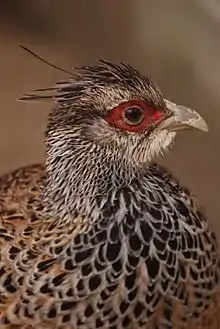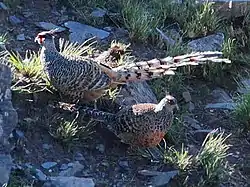Cheer pheasant
The cheer pheasant (Catreus wallichii), also known as Wallich's pheasant or chir pheasant, is a vulnerable species of the pheasant family, Phasianidae. It is the only member in the genus Catreus. The scientific name commemorates Danish botanist Nathaniel Wallich.
| Cheer pheasant | |
|---|---|
 | |
| At Kyoto Zoo, Japan | |
| Scientific classification | |
| Kingdom: | Animalia |
| Phylum: | Chordata |
| Class: | Aves |
| Order: | Galliformes |
| Family: | Phasianidae |
| Genus: | Catreus Cabanis, 1851 |
| Species: | C. wallichii |
| Binomial name | |
| Catreus wallichii (Hardwicke, 1827) | |
Description
.JPG.webp)

These birds lack the color and brilliance of most pheasants, with buffy gray plumage and long, gray crests. Its long tail has 18 feathers and the central tail feathers are much longer and the colour is mainly gray and brown. The female is slightly smaller in overall size.
Behaviour and ecology
Males are monogamous. They breed on steep cliffs during summer with a clutch of 10 to 11 eggs.[2] In studies conducted in upper Beas Valley, cheer pheasant was found to be sensitive to human disturbance.[3][4]
Habitat and distribution
The cheer pheasant is distributed in the highlands and scrublands of the Himalayas region of India, Nepal, Kashmir, and Pakistan. They are found mainly in the west of Nepal, Kumaon, Garhwal, Tehri Garhwal, Simla States, Bussahir, Kullu, Chamba till about the Hazara District. Surveys in 1981 and 2003 in the Dhorpatan area of western Nepal established 70 calling sites, suggesting substantial numbers exist in this area (about 200 birds).[5][6][7] In another survey in 2010, cheer pheasants were detected in 21 calling sites in Kullu district of Himachal Pradesh.[3] They are found mainly above 6000 feet altitude and up to 10000 feet in summer.[2]
Status and conservation
Due to ongoing habitat loss, small population size, and hunting in some areas, the cheer pheasant is evaluated as vulnerable on the IUCN Red List of Threatened Species.[1] It is listed on Appendix I of CITES.[8] Attempts to reintroduce captive-bred cheer pheasants in Pakistan have been unsuccessful.[9]
References
- BirdLife International (2004). "Catreus wallichi". IUCN Red List of Threatened Species. 2004. Retrieved 11 May 2006.
- Baker, EC Stuart (1918) The game birds of India, Burmay and Ceylon. J. Bombay Nat. Hist. Soc. 26(1):1-5 scan
- Jolli, Virat; Srivastav, A; Thakur, S (2011). "Patch occupancy for cheer pheasant Catreus wallichii in the Great Himalayan National Park Conservation Area" (PDF). International Journal of Galliformes Conservation. 2: 74–81. Retrieved 10 December 2012.
- Jolli, Virat & Pandit, M. K. (2011). " Influence of Human Disturbance on the Abundance of Himalayan Pheasant (Aves, Galliformes) in the Temperate Forest of Western Himalaya, India". Vestnik Zoologii 45 (6): e40-e47. doi:10.2478/v10058-011-0035-0
- Lelliott, A.D.(1981) Cheer Pheasants in west-central Nepal. World Pheasant Assoc. 6:89-95
- "PSG Project round-up" (PDF). Newsletter of the WPA/BirdLife/Species Survival Commission. Pheasant Specialist Group. Retrieved 14 January 2011.
- "Dhorpatan Hunting Reserve". birdlife.org. Birdlife International. Retrieved 14 January 2011.
- "Appendices I, II and III". cites.org. CITES. Archived from the original on 16 November 2008. Retrieved 8 December 2010.
- "Cheer Pheasant Catreus wallichi". birdlife.org. Birdlife International. Retrieved 8 December 2010.


